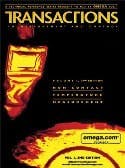Transactions in measurement and control -- 1.1
Chapter 1: A Historical Perspective
Our eyes only see the tiny fraction of energy emitted by the sun in the form of visible light. However, if we could see the infrared rays emitted by all bodies—organic and inorganic—we could effectively see in the dark. Though invisible to the human eye, infrared radiation can be detected as a feeling of warmth on the skin, and even objects that are colder than ambient temperature radiate infrared energy. Some animals such as rattlesnakes, have small infrared temperature sensors located under each eye which can sense the amount of heat being given off by a body. These sensors help them to locate prey and protect themselves from predators.
Non-contact temperature sensors use the concept of infrared radiant energy to measure the temperature of objects from a distance. After determining the wavelength of the energy being emitted by an object, the sensor can use integrated equations that take into account the body's material and surface qualities to determine its temperature. In this chapter, Transactions in Measurement and Control will focus on the history of radiation thermometry and the development of non-contact temperature sensors.
Non-contact temperature sensors use the concept of infrared radiant energy to measure the temperature of objects from a distance. After determining the wavelength of the energy being emitted by an object, the sensor can use integrated equations that take into account the body's material and surface qualities to determine its temperature. In this chapter, Transactions in Measurement and Control will focus on the history of radiation thermometry and the development of non-contact temperature sensors.
Topics covered include:
1. IR Through the Ages
2. From Newton to Einstein
3. Today's Applications
1. IR Through the Ages
2. From Newton to Einstein
3. Today's Applications
Other chapters of Transactions will systematically cover other aspects of temperature, humidity, pressure, strain, flow, level, pH, and conductivity instrumentation as well as other measurement, data acquisition and control topics. Click here to view the other chapters of Volume I, or to download Non-Contact Temperature Measurement in its entirety.
We hope the Transactions in Measurement and Control series will find a permanent home on your reference shelf, and that it proves itself of great value now and in the future.
Download Now to view and save Chapter One: A Historical Perspective.
Download Now to view and save Chapter One: A Historical Perspective.


